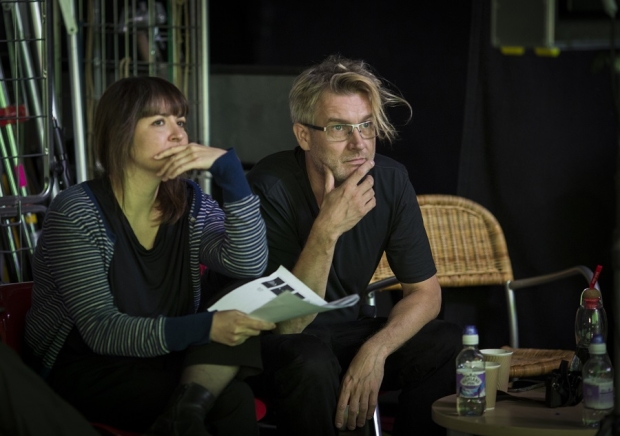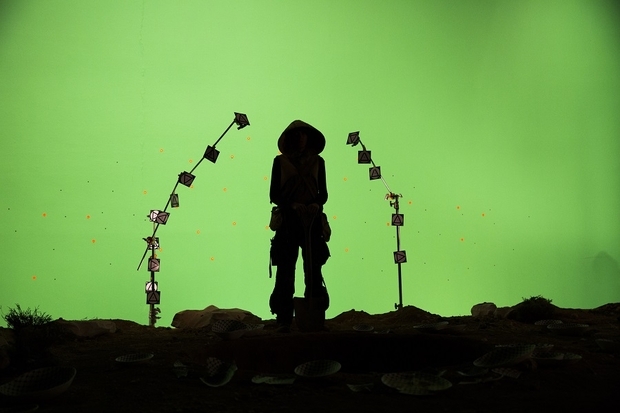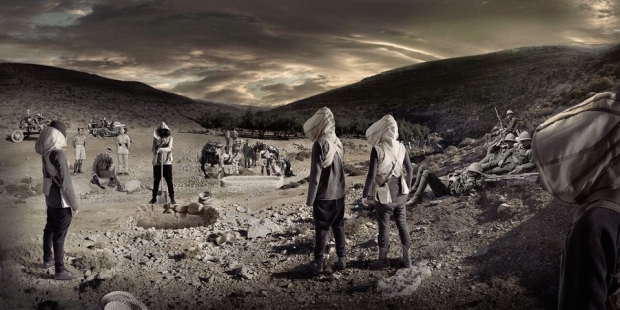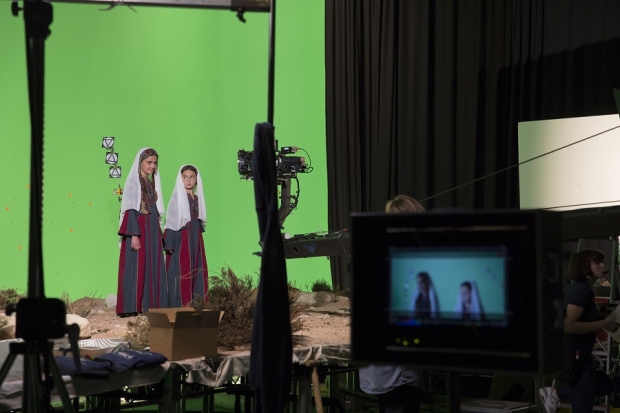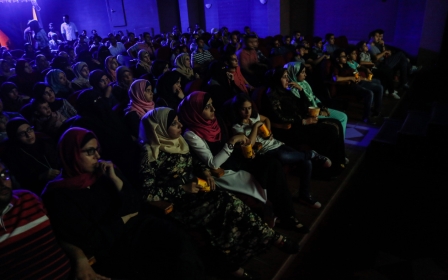For Palestine sci-fi film, a fictional future is easier to imagine than reality

When Larissa Sansour made her first documentary, Tank, in 2003 about peaceful Palestinian resistance to the Israeli army, she says that she was labelled a “propagandist” by "Israeli apologists".
As the Palestinian artist and filmmaker explains from a cafe in Venice, where she is on holiday with her Danish husband and creative partner Soren Lind and their young daughter, this experience propelled her to move away from documentary into the realm of fiction.
'We found out that the Palestinian predicament lends itself well to science fiction'
- Soren Lind, author
“I thought that fiction might be the realm to avoid accusations of make believe and that it would be easier to discuss things on fictional terms,” she muses, “elevating” Palestinian issues from the daily grind of competing rhetoric.
Sadly, recent accusations of “anti-Semitism" against Sansour and Lind’s recent film In the Future They Ate from the Finest Porcelain, have proven her wrong.
The film, part of the Barbican’s programming for Into the Unknown, A Journey Through Science Fiction, referenced work by Jules Verne, Margaret Atwood and Isaac Julien among others.
But after three months of uneventful screenings, a complaint by a member of the Jewish community that the film was “anti-Semitic” threatened to smear the film and its makers.
Accusations of anti-Semitism
Lind admits he was “shocked” that what he had thought was a “dying breed” of “automatic accusations of anti-Semitism based on any criticism of Israeli policies” still prevailed.
The idea that the Israeli/Palestinian issue is a question of two competing narratives is not true
- Soren Lind, author
On 22 August, Gillian Merron, the chief executive of the Board of Deputies of British Jews, wrote a letter to the Barbican's CEO Sandeep Dwesar, asking her to remove the film from the exhibition, writing: “While the Barbican synopsis casts the film as a sci-fi feature about fictitious technologically advanced aliens who land in an area to implant a ‘false history,’ I understand that the film is clearly filmed in Israel and that the dialogue is in Arabic and purports to show the ‘aliens’ seeding the land with porcelain in an effort to create the ‘false’ impression that they have a historical connection to it.”
Merron continued, saying, “It is therefore not much of a stretch to suggest that the film is a means by which to deny the historical Jewish connection to Israel and an exercise in delegitimisation. Accusing Jews of falsifying our connection to Israel smacks of anti-Semitism and is of grave concern.”
However, explains Soren Lind, “falsification or undermining the Israeli narrative is not the point of the film,” but rather the fact that “Palestinians are so disempowered that they have to forge an archeology that is undergoing erasure as we speak.”
“Although our film makes an effort to avoid direct references to Israel - in a deliberate attempt not to limit its implications to a singular context - the film's symbolism, its dialogue spoken in Palestinian Arabic and its topic matter certainly do situate it firmly within an Israeli/Palestinian framework. And yes, both Soren and I strongly oppose the Israeli occupation, but we thought and hoped that we had moved beyond the days when criticism of the policies of the state of Israel gave rise to automated accusations of anti-Semitism. I know that these are sensitive times, but this should give us all the more reason to refrain from simplistic and distorting political rhetoric.”
The whole idea that a connection gives an automatic right to land comes from a problematic sense of entitlement
- Soren Lind, author
She cited the Barbican’s support and thanked them for their statement, part of which read: “The Barbican is an apolitical organisation and our aim is to give the best artists from around the world a platform to showcase their work. While apolitical, the Barbican does not shy away from presenting work that invites discussion and debate and that represents a range of different perspectives.
"However, all artists who appear in the Barbican’s programme are there as a result of their exceptional artistic work and our relationship with them does not imply sympathy with their personal views or those of anyone associated with them.”
Lind notes that although the couple also received support from many in the Jewish community in the UK, including an art teacher who wrote to say she shows the film in her class to educate her students about the Palestinian situation, “We’re saddened we have to go through this kind of accusation which always stains a work of art.”
Sansour wrote a second statement on her Facebook page on 25 August. “It's always difficult to respond to other people's interpretations of your work, let alone politically charged and deliberately simplistic misreadings that go on to present themselves as proof of the work's inherent anti-Semitism. This leap from far-fetched reading to racist conclusion offends me personally, politically and intellectually.”
'Old fashioned legal claims'
In the Future They Ate from the Finest Porcelain was first conceived as a work of performance art, where pieces of imprinted pottery would be buried in various parts of Palestine. After the completion of the film in 2016, they decided to follow it with the performance piece. Lind had to do the actual burying, in collaboration with other Palestinian artists in the West Bank and Gaza, as Sansour’s Palestinian ID would have made freedom of movement very difficult.
“It’s been an ongoing project this idea of the politicisation of archeology,” says Lind.
“The idea that the Israeli/Palestinian issue is a question of two competing narratives is not true,” he contends.
“Projecting a state into the past supports the idea of historical settlement. It’s really clever, but scientifically unsound. But in this particular political arena, scientific rigour becomes irrelevant. In its most perverted form, archeology galvanises public sentiment, confirms the myths of the past and defends them against scrutiny. Now we are part of that game too.”
Palestinians have old fashioned legal claims and they are up against religiously inspired 'God given right to the land' narratives
- Soren Lind, author
While Lind says he does not disagree that the Jewish people have a historical connection to the land of Palestine, “the whole idea that a connection gives an automatic right to land comes from a problematic sense of entitlement”.
“Myth not only creates fact; it also generates identification… people will start associating themselves with it,” the protagonist in their film says.
While parts of walled-in Palestine today certainly resemble dystopian science fiction films from the 70s, it wasn’t until the pair did their short 2009 Stanley Kubrick inspired Space Exodus film - a richly textured dream-like narrative exploring displacement via the “first Palestinian in space”- that they embraced the genre.
“We found out that the Palestinian predicament lends itself well to science fiction – suspended between futuristic visions and memories of the past. Sci-fi is a good philosophical playground," relates Lind.
Overcoming controversy
This is not the first time the filmmakers have dealt with and overcome controversy. In 2011, the Elysee Museum in Lausanne, Switzerland, said that it came under pressure from its sponsor Lacoste to remove Sansour from the short list of their annual photography competition Prix Elysée Lacoste. Lacoste denied the accusation and withdrew their sponsorship.
Sansour’s work entitled Nation Estate, that the artist said represented “the birth of an imaginary Palestinian state reduced to a singular and immense sky-scraper,” was deemed “pro-Palestinian exaggeration,” according to reports.
But the attempt at censorship backfired, with media reports garnering support for Sansour. Eventually the museum cancelled the competition in solidarity with the artist.
In fact, the work of Sansour and Lind, which includes visual art, film, performance and literature, is often a kind of creative gestalt, with forms flowing freely into each other and often resulting in unintended creative, social and political consequences.
The recent controversy might well be a case of life imitating art imitating life, that may be reborn in their next project.
Continuing with the sci-fi theme, the couple is at work on a “post apocalyptic climate change film” about an underground orchard in Bethlehem where a group of seed keepers try to restore Palestine’s natural crops by using heirloom seeds.
But with Palestine “even further ahead on the eco-apocalypse timeline than many other places,” as Lind notes – with ongoing water issues and the damaging environmental impact of the wall and settlements, truth may no longer be stranger than science fiction.
This article is available in French on Middle East Eye French edition.
New MEE newsletter: Jerusalem Dispatch
Sign up to get the latest insights and analysis on Israel-Palestine, alongside Turkey Unpacked and other MEE newsletters
Middle East Eye delivers independent and unrivalled coverage and analysis of the Middle East, North Africa and beyond. To learn more about republishing this content and the associated fees, please fill out this form. More about MEE can be found here.


